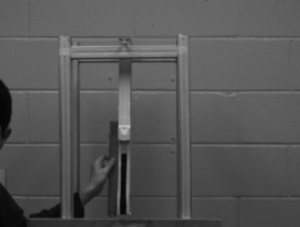Double pendulum
Double pendulum
Group members:
The double pendulum is a classic system in the study of chaos. We have explored the double pendulum experimentally, and compared results to a numerical simulation. This comparison was done in the time it takes for the second arm of the pendulum to ”flip,” based on initial starting conditions. We also performed analysis of the vertically driven case.

Overview
The double pendulum is a chaotic system as is expected [1, 2], since it is nonlinear and has a phase space of more than two dimensions. As such small differences in initial conditions grow exponentially [1]. Due to its simplicity and rich dynamical behavior, this system is widely used in introducing the concept of chaos [2]. Many introductory experiments use a driven double pendulum, as this permits longer periods of data gathering before damping of the system [2]. This driving typically takes the form of a motor driving the first joint of the pendulum in an oscillatory manner. An example of this is [3] which examined bifurcations leading to low-dimensional chaos using an apparatus of this nature.
Experiment

For our experiment, we used a double pendulum consisting of a rod supported by two others. The pendulum was connected to supports that could sinusoidally oscillate in the vertical direction at relatively low frequencies. We observed the motion of the pendulum at various initial positions, and noted whether it flips or not. If it did, the time it took was measured.
<videoflash>UBfS6mr2Ups</videoflash>
This was done by recording the motion of the pendulum with a high speed camera, and using a program that tracked the motion of the lower bar of the pendulum.
(see video below). The same method was used for the forced case.
Simulation
Using MATLAB, we simulated the motion of the pendulum at various initial conditions. The theory we mainly referenced can be found here
The green dots represent cases that, from our experiment, did flip. The red dots represent cases that did not. Note the good agreement of theory and experiment.
References
[1] Troy Shinbrot, Celso Grebogi, Jack Wisdom, and James A. Yorke, ”Chaos in a double pendulum,” Am. J. Phys., vol. 60, no. 6, pp. 491-499, June 1992.
[2] R. B. Levien and S. M. Tan, ”Double pendulum: An experiment in chaos,” Am. J. Phys., vol. 61, no. 11, pp. 1038-1044, November 1993.
[3] Peter Jäckel and Tom Mullin, ”A numerical and experimental study of codimension-2 points in a parametrically excited double pendulum,” Proc. R. Soc. Lond. A, vol. 454, pp. 3257-3274, 1998.